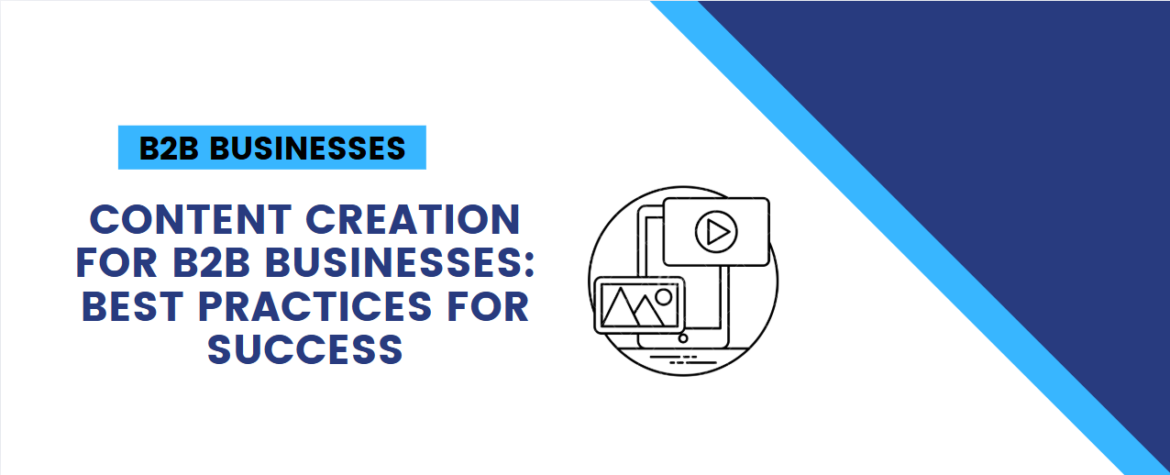In the world of B2B (business-to-business) marketing, creating valuable and relevant content is not just a choice—it’s a necessity. With the growing demand for meaningful connections and the increased reliance on digital channels, businesses need to create content that speaks directly to the needs and pain points of other businesses. However, content creation in the B2B space is distinct from B2C (business-to-consumer) content, as it requires a deeper understanding of your audience’s challenges, decision-making processes, and the long-term nature of business relationships.
So, how can B2B companies create content that drives engagement, builds trust, and ultimately leads to more conversions? In this blog, we’ll explore best practices for successful B2B content creation.
1. Know Your Target Audience
The foundation of any content strategy is understanding your audience. In B2B marketing, your audience is often made up of professionals, managers, and decision-makers who are looking for solutions to specific problems. These are individuals who are highly informed, and their decisions are based on data, ROI, and how well your product or service can address their pain points.

Actionable Tips:
- Segment your audience: Different industries and roles within companies have varying needs. A C-suite executive might be interested in the strategic impact of your solution, while an IT manager might care more about technical features and implementation.
- Use data-driven insights: Gather data from your website analytics, customer surveys, and sales team to understand what content your audience is engaging with most.
Example: A software company selling enterprise solutions should create different content for CTOs, marketing heads, and IT managers, addressing their unique concerns and responsibilities.
2. Create High-Quality, Value-Driven Content
In B2B content creation, quality is crucial. Your audience isn’t looking for fluff—they want value. This is where in-depth content like case studies, whitepapers, webinars, blog posts, and eBooks can be extremely effective. These content types allow you to showcase your expertise, provide actionable insights, and establish your brand as a trusted thought leader in your industry.

Actionable Tips:
- Use data and insights: Back up your claims with facts, figures, and research. According to a Content Marketing Institute study, 70% of B2B marketers say that research reports and data-backed content are the most effective in establishing credibility.
- Offer solutions: Position your product or service as the solution to the challenges your audience faces. For example, an article titled “How to Overcome Supply Chain Challenges in 2024” could address issues while subtly demonstrating how your solution can help.
Example: A manufacturing company can create a case study detailing how its software helped another business improve productivity by 30%. This kind of real-world example makes your content more relatable and credible.
3. Leverage SEO for Greater Visibility
Even the best content can fall flat if no one can find it. SEO (Search Engine Optimization) plays a huge role in helping your content get discovered online. If your content isn’t optimized for the right keywords, you might miss out on valuable traffic and leads.
Best Practice: Optimize all content for SEO to ensure it ranks well in search engines. This involves using relevant keywords, including long-tail keywords, and optimizing for user intent.

Actionable Tips:
- Keyword research: Use tools like Google Keyword Planner or SEMrush to find relevant keywords for your industry. Focus on long-tail keywords (e.g., “how to improve warehouse efficiency with AI”) as they often convert better in B2B contexts.
- On-page SEO: Optimize content elements such as titles, meta descriptions, headers, and image alt text. Ensure your website is mobile-friendly and has fast loading times.
- Internal linking: Use internal links to guide visitors through your content and increase the time they spend on your site. This boosts your chances of converting them into leads.
Example: A cloud services provider could create blog posts around highly searched keywords like “best cloud solutions for remote teams” or “how to choose a cloud provider for your business,” ensuring the content addresses popular queries in their niche.
4. Tell Compelling Stories
B2B decision-making is often driven by logic, but that doesn’t mean your content can’t include a human touch. Storytelling is an effective way to engage your audience emotionally while also conveying the value of your product or service. Good stories connect with the audience on a deeper level and help them visualize how your solution can benefit them.

Actionable Tips:
- Use customer stories: Highlight how your product or service has helped other businesses solve problems. These stories can be shared through case studies, testimonials, or video interviews.
- Humanize your brand: Show the people behind your company, how they’re working to solve industry challenges, and how your brand values align with your audience’s values.
Example: A logistics company can feature a video case study of a client explaining how their service helped streamline their supply chain and save costs, providing tangible proof of the solution’s effectiveness.
5. Distribute Your Content Across the Right Channels
Creating great content is only half the battle. The next step is ensuring that your target audience sees it. Different types of content perform best on different platforms, so it’s essential to distribute content in the right places.
Best Practice: Promote your content on the channels where your target audience is most active. This includes LinkedIn, email newsletters, industry forums, paid ads, webinars, and YouTube.

Actionable Tips:
- Leverage LinkedIn: As a B2B platform, LinkedIn is the ideal place for sharing long-form content like articles, case studies, and blog posts. It also allows you to join industry-specific groups and connect with potential leads.
- Paid advertising: Consider running LinkedIn ads, Google Ads, or retargeting campaigns to amplify your content and reach a wider audience.
- Email marketing: Use email campaigns to distribute content directly to your existing customer base or prospects. Email open rates for B2B marketing can be as high as 20-25% when done correctly.
Example: A SaaS company can share product demos on YouTube, distribute whitepapers through targeted LinkedIn ads, and send case studies via email newsletters to nurture existing leads.
6. Use Data to Measure and Optimize
Content creation is an ongoing process that needs continuous improvement. The key to success lies in constantly measuring how well your content is performing and making adjustments where needed.
Best Practice: Track content performance using analytics tools like Google Analytics, HubSpot, or Marketo. Measure metrics such as website traffic, bounce rates, lead conversions, and social media engagement.

Actionable Tips:
- A/B testing: Test different content formats, headlines, or CTAs (call-to-action) to see what resonates most with your audience. Small tweaks can lead to better results.
- Track KPIs: Focus on important metrics such as conversion rates, lead generation, and engagement rates to determine the effectiveness of your content.
- Content feedback: Ask your audience for feedback through surveys or social media polls to understand what kind of content they find most helpful.
Example: A company selling enterprise software might track which blog posts or videos generate the most demo requests and then create more content around those specific topics or pain points.
7. Nurture Leads with Ongoing Content
In B2B sales cycles, it often takes time for leads to make a purchasing decision. Therefore, lead nurturing is essential. Offering content throughout the buyer’s journey helps keep leads engaged, educated, and moving toward conversion.
Best Practice: Develop a content strategy for each stage of the sales funnel—awareness, consideration, and decision-making. Create content that addresses your audience’s needs at each stage.

Actionable Tips:
- Top of funnel (TOFU): Create blog posts, infographics, and guides that raise awareness about the challenges your audience faces.
- Middle of funnel (MOFU): Offer eBooks, case studies, and webinars that help potential customers consider your solution.
- Bottom of funnel (BOFU): Use product demos, testimonials, and ROI calculators to help leads make the final decision.
Example: A B2B IT company might start with a blog post about cloud storage trends (TOFU), then move to a webinar on how cloud storage can improve business efficiency (MOFU), and finish with a case study or product demo (BOFU).
Conclusion
Content creation in the B2B space is not just about pushing out promotional material. It’s about providing value, solving problems, building trust, and fostering long-term relationships with your customers. By knowing your audience, creating high-quality content, optimizing for SEO, and distributing content across the right channels, you’ll be well on your way to achieving successful content marketing that drives conversions, enhances brand awareness, and improves customer retention.
Start by following these best practices, continuously measuring your results, and adapting your strategy to meet the ever-evolving needs of your audience. The impact of effective content creation in B2B businesses is immense—it’s time to harness its full potential.


